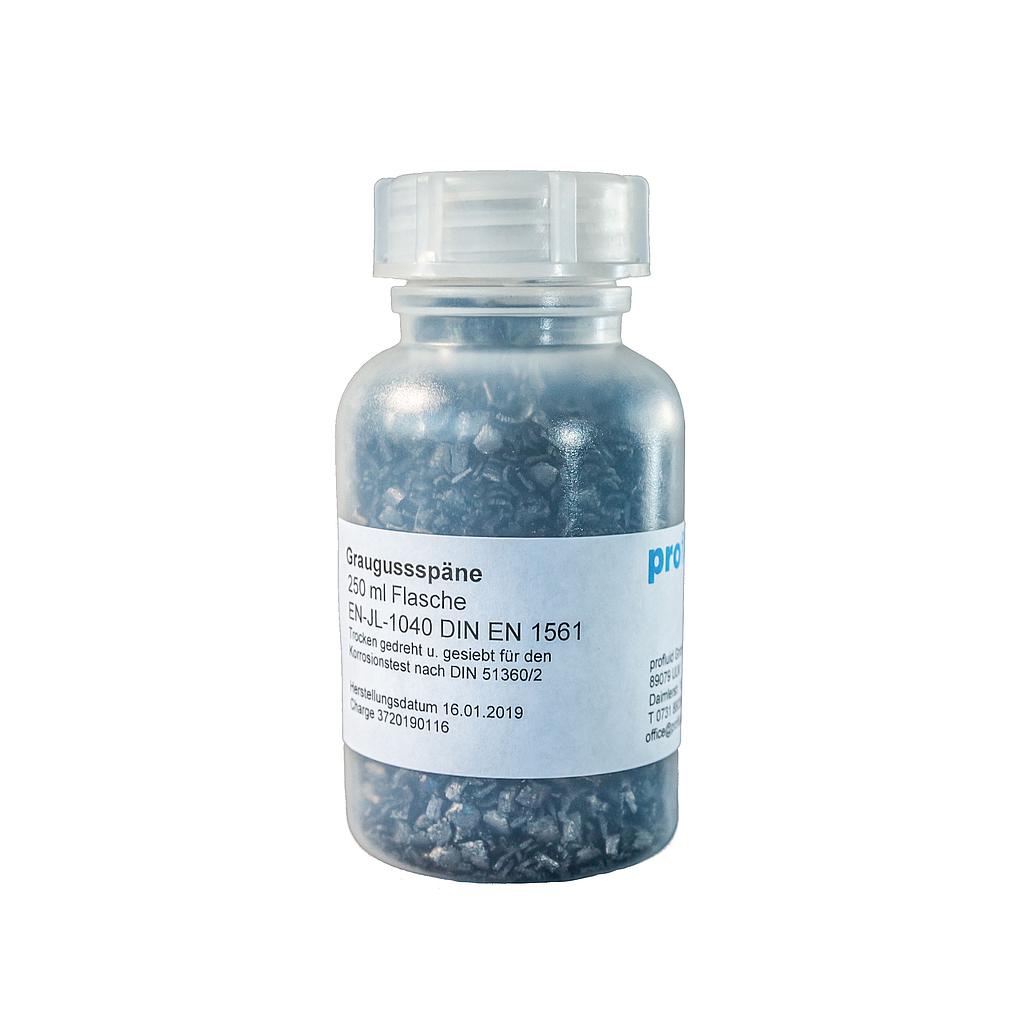profluid®
Grey Cast Iron Chips - DIN 51360-2
Probably the simplest corrosion protection test

Standard-compliant grey cast iron chips made of GG25 according to DIN 51360-2
aus GG25 nach DIN 51360-2
You want to make sure that your machines, plants and products that come into contact with cooling lubricants, drilling emulsions, cleaning agents, cooling and quenching media are not exposed to an unnecessary risk of corrosion (rust)?
Do you develop water miscible coolants, media for corrosion protection or cleaners ?
Our grey cast iron chips are dry milled, sieved and dry packed from GG25 exactly according to the specifications of DIN51360-2. With our grey cast iron chips (also contained in the profluid CorrSet), you can easily determine in 2h whether the corrosion protection for steel and cast materials is sufficient.
Simply order in our online shop.
All your advantages at a glance:
Test result in 2h
After the test has been prepared, the grey cast iron chips only have to be brought into contact with the medium to be tested.
Uncomplicated testing of corrosion protection properties
From water-mixed cooling lubricants, drilling emulsions, cleaners, cooling and quenching media.
Meaningful according to DIN 51360-2
Classification according to DIN 51360-2
Continuous and meaningful results
We are experts in the field of corrosion and manufacture our swarf ourselves and somot always ensures consistent quality.
Execution of the corrosion protection test according to DIN51360-2
Howto Check Corrosion Protection of MWFs by DIN51360-2
Step 1:
Place the filter paper in the Petri dish. (The description differs slightly from the norm, where 70mm diameter filter paper is used, with a circle (pencil) of 40mm. We recommend 55 mm filter paper, without circle, because there are very inexpensive Petri dishes for this.)
Step 2:
Weigh approx. 2g chips directly into the Erlenmayer or the test tube (25-35 pieces) - do not touch the chips by hand before testing.
Step 3:
Pipette cooling lubricant solution onto the chips until they are thoroughly wetted.
Step 4:
Tip wet chips into the Petri dish. (The filter should become wet over the entire surface, but the chips should not be flooded with coolant - if necessary remove excess liquid.) Distribute chips as evenly as possible.
Step 5:
Start clock
Step 6:
After 2 hours, tilt the chips out of the Petri dish, remove the wet filter with tweezers, rinse the filter briefly with water and allow to dry. (Alternatively, immerse the wet filter briefly in acetone and allow to dry.)
Evaluation:
Compare the corrosion pattern with the original from the standard. The desired value is level 0 = no corrosion, 1 is still quite good, above this level is actually not tolerable. (There is also a reading scheme in the standard). Classification is possible to 1 level).
Comment on the procedure
The test is a bit rough, but very useful if you can't explain why parts or machines rust or when it comes to comparing KSS. The chips must, of course, be manufactured in accordance with the standards.
The standard distinguishes 4 degrees of corrosion according to the number and size of the spots, 0 means no corrosion 4 indicates serious deficiencies in corrosion protection. The standard should be obtained from Beuth-Verlag (https://www.beuth.de) to ensure that it is carried out and evaluated in accordance with the standards. This method can be used to check the condition of coolant lubricants on machines used for steel and grey cast iron machining or to protect machine beds made of grey cast iron against corrosion in good time.
Reasons for inadequate corrosion protection in water-mixed KSS:
-
Faulty equipment of the KSS recipe - Manufacturer's error
-
Use of too low concentrations
-
Degradation of the KSS by germs
-
Chloride concentrations too high due to salting from the preparation water
-
.... Many other reasons we can help you with.
A typical question:
Comparison of the corrosion protection of two water-mixed cooling lubricants:
Prepare both cooling lubricants with the same preparation water. (Use your own process water for this.) Concentrations: 2% 3% 4% 5% 6%. Mix well before the test to obtain a uniform emulsion.
For each concentration level:
Weigh 2g chips into a 50 ml Erlenmeyer. Mark the Erlenmeyer with a felt pen e.g. A2%, A3%, A4% ...B2%, B3%, B4%...
Place one round filter in each Petri dish. Put the same inscription on the lid as on the Erlenmeyer flask. (2 samples are used for each concentration level in accordance with the standards.)
See above for other procedures.
High quality and standards-compliant, as you expect.
Keep an eye on corrosion and control quality